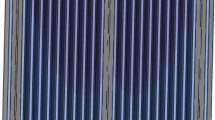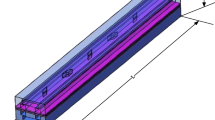Abstract
Among the various types of fuel cells, the polymer electrolyte fuel cell (PEFC) is one of the prospective power sources for automotive applications, stationary cogeneration systems, and mobile electronic devices. The PEFC is very sensitive to the high temperature environment inside the fuel cell, and non-uniform temperature distribution reduces its performance. In this study, the performance of cooling plates for the PEFC was investigated by using three-dimensional computational fluid dynamics with commercial software. Six cooling plates were designed with different channel configurations. Models 1 and 4 had typical serpentine and parallel configurations, respectively. Models 2 and 3 had modified serpentine structures from Model 1, while Models 5 and 6 had modified parallel structures from Model 4. Models 1 and 2 showed relatively high temperatures around the outlet and the inlet area of the channel, respectively. Cooling performance of Models 4 and 5 was lower than that of Model 6 due to non-uniform fluid flow and temperature distributions. Models 3 and 6 showed higher cooling performance than serpentine type models and parallel type models, respectively. The performance of Model 3 was superior to that of Model 6 with respect to the control of the maximum surface temperature and uniformity. The thermal performance of Model 3 improved over Model 6 with the increase of heat flux. However, the pressure drop of Model 3 was higher than that of Model 6 because Model 3 had relatively high flow velocity through its channel and greater number of bends than Model 6.
Similar content being viewed by others
References
N. Djilali and D. Lu, Influence of heat transfer on gas and water transport in fuel cells, International Journal of Thermal Science, 41(1) (2002) 29–40.
P. F. Oosterkamp, Critical issues in heat transfer for fuel cell systems, Energy Conversion & Management, 47(20) (2006) 3552–3561.
J. V. C. Vargas, J. C. Ordonez and A. Bejan, Fuel cells constructal optimization and research perspective, Fuel Cell Science, Engineering and Technology, Rochester, New York, USA, 2004, 67–78.
J. M. Ogden, M. M. Steinnbugler and T. G. Kreutz, A comparison of hydrogen, methanol and gasoline as fuels for fuel cell vehicles: Implications for vehicle design and infrastructure development, Journal of Power Sources, 79(2) (1999) 143–168.
F. Barbir, PEM Fuel Cells: Theory and Practice, Elsevier Academic Press, Burlington, 2005, pp. 76–81.
G. Inoue, T. Yoshimoto, Y. Matsukuma, M. Minemoto, H. Itoh and S. Tsurumaki, Numerical analysis of relative humidity distribution in polymer electrolyte fuel cell stack including cooling water, Journal of Power Source, 162(1) (2006) 81–93.
T. Nguyen and R. White, A water and heat management model for proton-exchange-membrane fuel cells, Journal of Electrochemical Society, 140(8) (1993) 2178–2186.
J. Yi and T. Nguyen, An along-the channel model for proton exchange membrane fuel cells, Journal of Electrochemical Society, 145(4) (1998) 1149–1159.
S. Rogg, M. Hoglinger, E. Zwittig, C. Pfender, W. Kaiser and T. Heckenberger, Cooling modules for vehicles with a fuel cell drive, Fuel Cells, 3(3) (2003) 153–158.
Y. Zhang, M. O. Q. Lu, J. Luo and X. Li, A model predicting performance of proton exchange membrane fuel cell stack thermal systems, Applied Thermal Engineering, 24(4) (2004) 501–513.
J. Larminie and A. Dicks, Fuel Cell System Explained, 2nd Ed., Wiley, 2002.
X. Li, Principles of Fuel Cells, Taylor & Francis Group, 2006.
H. O. Pierson, Handbook of Carbon, Graphite, Diamond and Fullerenes: Properties, Processing and Applications, Noyes Publications, 1993.
F. C. Chen, Z. Gao, R.O. Loutfy and M. Hecht, Analysis of optimal heat transfer in a PEM fuel cell cooling plate, Fuel Cells, 3(4) (2003) 181–188.
ESI US R&D, CFD-ACE+ Theory Manual, ESI US R&D Inc., 2004.
S. V. Patankar, Numerical Heat Transfer and Fluid Flow, Hemisphere, Washington DC, 1980.
J. W. Jeon, Y. Kim, J. M. Choi, H. Kang and D. W. Cheon, Performance comparison of liquid-cooling with air-cooling heat exchangers for telecommunication equipment, The 3rd Asian Conference on Refrigeration and Air-conditioning, Korea, 2006.
Author information
Authors and Affiliations
Corresponding author
Rights and permissions
About this article
Cite this article
Choi, J., Kim, YH., Lee, Y. et al. Numerical analysis on the performance of cooling plates in a PEFC. J Mech Sci Technol 22, 1417–1425 (2008). https://doi.org/10.1007/s12206-008-0409-6
Received:
Revised:
Accepted:
Published:
Issue Date:
DOI: https://doi.org/10.1007/s12206-008-0409-6




